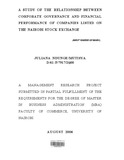| dc.description.abstract | Corporate governance is the system through which corporations are directed and controlled.
On the other hand, the main goal of companies is to maximise the wealth of shareholders.
With the recent problems across the world for example the collapse of major corporations
like Enron, the impact of corporate practises has increased profoundly. Public companies are
issuing more and more of their shares to the public as they seek to expand. Governments are
also reducing their control in state owned corporations through the sale of their shareholding
to the public. With such growth in the amount of control being relinquished to the public, the
public in return demand better governance of their corporations. With the Cadbury Report of
1992, the OECD principles of corporate governances of 1999 and close home, the C\1A
guidelines on corporate governance, there is a benchmark that companies are required to
follow. This gives stakeholders an opportunity to judge if their companies are being run
according to the set guidelines. The methodology comprised running a multivariate
regression model. The dependent variable, company performance was measured using two
measures. The Return on Investment (ROI) and the Market to Book Value (MBV). The
independent variables included, the board size, the proportion of outside directors, the
proportion of inside directors, average age of the directors, the number of meetings held by
the board in a year, the proportion of shares held by directors, proportion of shares held by
the top shareholder, the proportion of shares held by the top ten (10) shareholders and the
number of women in the board. The general expectation was that there would be a positive
relationship between profitability and the aspects of corporate governance indicated above.
Also investigated were the ages of chairpersons, their professions and number of
chairmanships held. The study covered the period between 2000 to 2005. The regression
model showed that 4.3% of the changes in profitability were accounted for by the aspects of
corporate governance studied when profitability was measured using the ROI and 22% when
profitability was measured using the Market to Book Value. Board size, number of meetings
in a year and the proportion of shares held by the top directors were the most significant
variables in the model. The number of women sitting on corporate boards was found to be
very small, just 2% comparing well with Japan but not the rest of the world | en_US |

